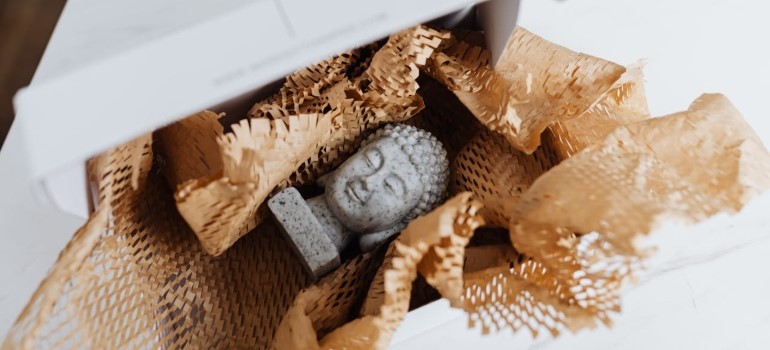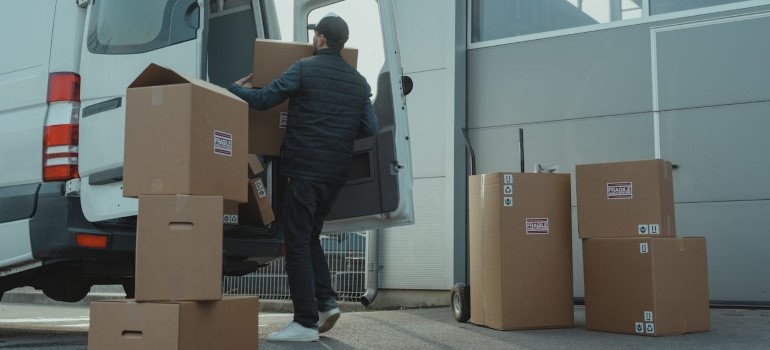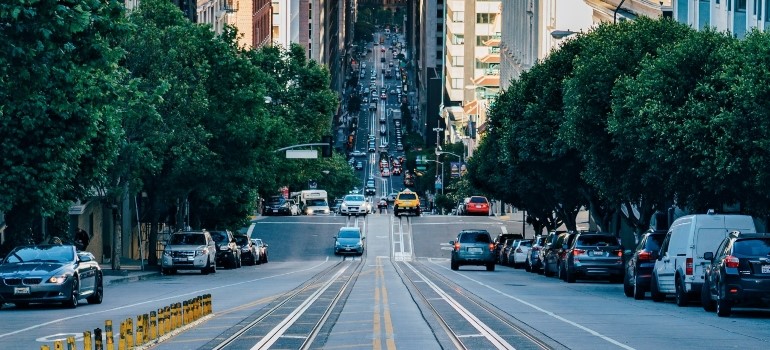Fine art represents history, culture, and value. Collectors in California understand that transporting artwork requires care. Paintings, sculptures, and antique pieces react to temperature shifts, vibrations, and poor handling. Damage lowers value, and restoration takes time and money. Collectors must take charge when moving fine art across California. Reputable Bay Area moving companies handle high-value pieces with professional methods. Custom crating, climate control, and secure transport reduce risks. Planning ahead helps protect artwork during relocation. Follow these expert steps for a safe move.
Why Do People Even Have Art Collections?
Art collection represents a deep connection between individuals and culture, history, and aesthetics. People collect art for various reasons—some see it as a financial investment, while others value it for personal enjoyment or historical significance. A collector may focus on paintings, sculptures, or rare artifacts, each piece reflecting a unique story or artistic movement. Many collectors view their acquisitions as a legacy, intending to pass them down through generations.
The global art market continues to grow, driven by both private collectors and institutional buyers. According to the 2023 Art Basel & UBS Art Market Report, the global art market reached $67.8 billion, with 36% of high-net-worth individuals actively collecting art. In the United States alone, the number of art collectors has increased, with over 9.3 million households estimated to own at least one piece of fine art.
Collectors often seek artwork that aligns with their taste, cultural background, or social status. Some purchase pieces from galleries or auctions, while others prefer discovering emerging artists. At the same time, Americans move frequently, with the U.S. Census Bureau reporting that the average person moves 11.7 times in their lifetime. This means that nearly every art collector will have to relocate their collection at least once. Art collection shapes museums, influences trends, and preserves history. Whether for passion or profit, owning fine art remains a meaningful and widely practiced endeavor, spanning centuries and cultures.

Why does moving fine art in California require special expertise?
Transporting fine art across California comes with specific risks. Every region creates unique threats for artwork.
- San Francisco’s humidity warps wooden frames, while Los Angeles’ dry air causes cracking.
- Earthquake risks require shock-resistant crates and secure truck placement.
- Heavy traffic on I-5 and Highway 101 increases transit time, leaving art exposed to changing conditions.
Collectors must prepare for these obstacles. Experienced movers understand the demands of California’s landscape. They use climate-controlled trucks, advanced packing methods, and efficient routing to keep the artwork safe.
The risks of improper art handling
Fine art demands precise conditions. Moving introduces risks that threaten its integrity. Sudden temperature changes cause wood to expand or contract, leading to cracks in paint and weakening adhesives. Humidity fluctuations create an environment where mold forms on canvases, while metal sculptures become susceptible to corrosion. Vibrations from road travel jolt delicate frames, shatter glass, and stress sculptures beyond their structural limits. Improper packing compounds these risks—overly tight wrapping puts pressure on surfaces, while loose packing allows the artwork to shift, increasing the likelihood of damage.
Handling errors often results in irreversible harm. Only professional art movers employ proven techniques that safeguard fine art, ensuring each piece reaches its destination intact.
Best practices for packing and protecting fine art
Moving fine art across California requires precision, skill, and the use of some fool-proof packing techniques! No one will do it better than skilled, trained Bay Area residential movers, but many people still like to go the DIY route. If you are this person, you can never read to many tips!

Use the right packing materials for moving fine art across California
Art collectors must select the right materials for packing. Poor choices cause scratches, pressure damage, or discoloration. California’s coastal and inland climates create different risks.
- Glassine paper shields paintings from moisture, dust, and static.
- Acid-free tissue paper prevents chemical reactions that degrade artwork.
- Corner protectors secure framed pieces, preventing dents and chips.
- Custom-built wooden crates hold sculptures and oversized items, keeping them stable.
Fine art deserves expert handling. Many local movers San Francisco Bay Area offers have specialized packing solutions, ensuring artwork stays safe throughout transport.
Opt for climate-controlled packing and transport
Temperature and humidity swings put art at risk. A sealed, climate-controlled space ensures stability. California’s heatwaves create conditions that damage canvases and wooden pieces. Without proper precautions, prolonged exposure to high temperatures warps wooden frames and causes paint to deteriorate. Climate-controlled trucks prevent these sudden heat shifts during long drives, maintaining stable conditions for artwork.
Vibrations from transit also pose a significant threat. Road conditions vary across California, and without the right equipment, delicate pieces suffer stress that leads to cracks and fractures. Air-ride suspension systems absorb shocks, reducing the impact that bumpy roads have on fine art.
Humidity fluctuations introduce yet another risk. Paintings and antique materials require stable moisture levels to prevent deterioration. Professional movers use humidity monitors to track environmental changes and ensure consistent protection. Fine art requires absolute care. A move across California means adapting to different environments—dry inland air contrasts with coastal moisture, and each shift affects artwork differently. Experienced professionals anticipate these changes and implement precise strategies to minimize risk.
Use custom crating for maximum protection
Every artwork requires a custom fit. Standard crates fail to provide the stability needed to keep fragile pieces secure. Without proper support, delicate sculptures and framed art shift during transit, increasing the risk of damage.
Shock-absorbing padding plays a crucial role in protecting sculptures inside crates, preventing sudden jolts from causing fractures. Tailor-made wooden frames add another layer of security by reinforcing structural integrity and reducing stress on delicate materials. Sealed barriers keep art safe from sudden climate shifts, shielding it from temperature fluctuations and humidity changes that often occur during long-distance moves.
Collectors understand that moving fine art across California requires careful preparation. Road conditions, unpredictable weather, and transit vibrations all pose threats. Crates must withstand sudden stops and shifting truck movement to ensure artwork remains undisturbed. Experts long distance movers San Francisco know how to use the strong, secure crates that provide reliable protection, keeping each piece in its original condition from pickup to final placement.

Choosing the right fine art moving company in California is very important
Hiring the right moving company is probably the best thing you can do to ensure that you artwork remains safe during transport. But in order to find the right professionals, you have to know what to look for and how to compare the different options available in California.
What to look for in a fine art moving company?
Moving valuable artwork requires expert handling. Not all movers understand the delicate nature of fine art. A reliable company offers more than transportation. It protects, secures, and preserves each piece. You need to find professionals who have:
- Experience with museum-quality art ensures proper techniques.
- Climate-controlled trucks prevent sudden temperature shifts.
- High-security storage keeps artwork safe during delays.
- Trained specialists understand how to handle fragile frames and sculptures.
Collectors need professionals who value art as much as they do. Our interstate movers San Francisco offer customized solutions for moving high-value pieces across California and beyond.
Why is Upline Moving a trusted partner for fine art relocations?
Collectors deserve movers who prioritize safety. Every piece holds significance, and one mistake can ruin its integrity. Upline Moving specializes in secure fine art transport, bringing years of experience in handling paintings, sculptures, and antique collections. Their expertise ensures artwork remains protected against environmental threats and physical impact.
Using museum-grade packing materials, they shield fine art from humidity fluctuations and unexpected shocks during transit. Each move requires a tailored approach, and Upline Moving develops customized transport plans based on the specific needs of every client.
California’s climate and road conditions introduce risks that threaten artwork. Heatwaves, coastal moisture, and unpredictable traffic increase the potential for damage. Upline Moving minimizes these dangers through climate-controlled transport and expert handling, ensuring fine art remains in pristine condition from start to finish.

What about fine art insurance during relocation?
A standard moving policy does not offer full protection. Fine art requires specialized coverage that accounts for its unique risks. Collectors must ensure their artwork remains financially protected by choosing the right insurance options.
Basic moving insurance provides minimal coverage, often paying only a small fraction of an artwork’s value. Many policies calculate reimbursement based on weight rather than market worth, leaving collectors with significant financial losses if damage occurs. This type of coverage works for standard household items but fails to safeguard fine art properly.
Specialized fine art insurance offers broader protection against fire, theft, and accidental damage. These policies cover the full appraised value of each piece, ensuring compensation reflects the artwork’s true worth. Fine art insurance also extends to risks specific to transport, such as exposure to extreme temperatures or vibrations that could cause deterioration.
Comprehensive plans provide the highest level of protection, fully replacing the artwork’s value in case of loss. These policies often include restoration coverage, reimbursing collectors for professional conservation efforts if damage occurs. Fine art insurance is an essential safeguard, ensuring collectors do not face irreversible financial loss.
Fine art deserves security beyond physical care. Insurance offers peace of mind. Full service moving services providers offer expert guidance on selecting the right policy for a stress-free move, ensuring every piece arrives protected and fully covered.
How do you document artwork for insurance claims?
Proper documentation ensures insurance claims hold up. Collectors must take steps before the move to verify condition and value.
- Photograph every piece from multiple angles, capturing existing flaws.
- Obtain professional appraisals to confirm market value.
- Keep receipts and records for verification in case of damage.
A move across California means encountering different risks. Moving fine art across California requires more than safe transport. It demands thorough documentation to protect financial investments.

You might need to store fine art safely before or after a move
Everyone expects their move to go smoothly without hiccups and delays, but that rarely happens. Instead of having to put a plan together last minute, be proactive and think about potentially having to use storage before you even hit the road.
When could you benefit from temporary storage?
Not every move allows immediate placement of fine art. Delays create risks, leaving collectors with the challenge of finding a secure location for their pieces. Some must store artwork for weeks or even months before installation, depending on their circumstances.
Home renovations create an environment filled with dust and vibrations, both of which can harm delicate surfaces and weaken frames. Collectors who plan major construction projects must keep fine art away from unstable conditions until their space is ready. Downsizing presents another challenge, as limited space makes it difficult to decide where each piece belongs. Temporary storage provides a safe option while collectors assess their new layout.
Coastal humidity poses a significant risk, especially in areas near the ocean where moisture can cause warping, mold growth, and discoloration. Certain materials, such as canvas and wood, absorb moisture quickly, requiring controlled storage to prevent deterioration.
A rushed move increases the chance of damage. Finding a secure facility prevents unnecessary exposure to unpredictable conditions. Art movers San Francisco offer climate-controlled storage solutions that keep valuable collections safe until the time comes for proper installation.
What features should you look for in a fine art storage facility?
Not all storage units suit fine art - this is one of the main things to consider when choosing a storage unit. Collectors need spaces that control climate, protect against theft, and prevent handling errors.
- Temperature-controlled environments maintain stable humidity.
- 24/7 surveillance ensures no unauthorized access.
- Private viewing rooms allow careful inspections before transport.
A well-chosen facility protects fine art from heat, moisture, and sudden impacts. Experts understand the delicate balance required for safe storage.
Tips for unpacking and displaying art in your new home
Once that you have reached your new home, you might think that the worst has passed and your art is out of the danger zone. While mostly true, mishaps can happen even during unpacking and displaying your precious pieces.
Safe unpacking techniques
Fine art requires patience. Moving too fast increases the risk of scratches, tears, or improper placement. Collectors must handle each piece with care to avoid avoidable damage.
Wearing gloves prevents natural oils from skin from transferring onto delicate surfaces, which can cause discoloration or weaken protective coatings. Letting artwork sit in its new environment before unwrapping helps it adjust to temperature and humidity levels, reducing stress on fragile materials. Once unwrapped, every piece must be inspected closely for unnoticed damage that may have occurred during transport. Even small cracks, loose frames, or subtle warping require immediate attention to prevent further deterioration.
Proper handling preserves the integrity of fine art. A single mistake can result in permanent harm, making careful unpacking an essential step in every move.
Proper wall mounting and placement
Collectors must plan for safe placement. Improper mounting weakens frames and causes long-term damage. Try to:
- Use secure wall anchors prevent heavy frames from shifting.
- Install UV-protective glass that shields artwork from light exposure.
- Avoid moisture by keeping art away from air vents and humid spaces.
Positioning affects longevity. Moving fine art across California means accounting for environmental conditions inside and outside the home.

Trust experts for a safe and seamless fine art move
Collectors must take control. Art holds value, history, and meaning. A safe move requires professionals who understand the risks. Moving fine art across California means handling climate changes, unpredictable traffic, and earthquake risks. Expert movers protect each piece. From packing to storage, every step matters. Secure transport ensures art arrives intact. Fine art deserves precision, care, and expertise. Work with professionals who understand that value extends beyond price.
Subscribe to Upline Moving's Blog










